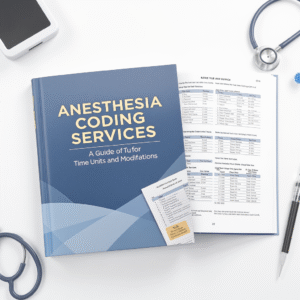Anesthesia Coding Services: A Complete Guide to Time Units and Modifiers to Maximize Reimbursement
Anesthesia Coding Services
Anesthesia Coding Services. In the complex ecosystem of medical billing, few fields present as many technical challenges and financial optimization opportunities as anesthesia coding. Even for the most experienced medical coders and billers, this specialty represents a unique territory where technical precision translates directly into financial viability. Anesthesia coding requires not only a thorough command of American Medical Association (AMA) CPT codes and American Society of Anesthesiologists (ASA) classifications, but also a nuanced understanding of evolving payer policies and federal regulations.
In the world of anesthesia, time is literally money. This statement, although it may sound trite, represents a fundamental reality that distinguishes anesthesia coding from virtually all other medical specialties. Every minute not properly documented can result in significant revenue losses, while every incorrectly applied modifier can trigger costly audits or systematic claim denials.
This comprehensive guide provides a thorough analysis of the complexities inherent in anesthesia coding services, offering proven strategies to maximize reimbursement while maintaining unwavering regulatory compliance. We’ll explore everything from the basics of time units to more specialized modifiers, providing detailed examples and best practices that will transform the efficiency of your anesthesia practice.

Unique Fundamentals of Anesthesia Coding: Beyond Traditional Codes
The Fundamental Difference: Time as a Billing Basis
Anesthesia coding is fundamentally distinguished from other medical specialties by its dependence on time as a primary billing component. While most medical services are billed based on discrete procedures performed, anesthesia represents a continuous and dynamic service that extends throughout the entire surgical episode.
This fundamental difference requires a completely different approach to documentation, coding, and billing. Anesthesiologists don’t simply perform a procedure; they provide a comprehensive service of monitoring, adjustment, and risk management that evolves moment by moment throughout the entire surgical intervention.
Multi-layered Regulatory Complexity
Anesthesia coding must simultaneously navigate multiple regulatory frameworks:
- WADA CPT Guidelines establishing base codes and service descriptions
- ASA classifications that determine physical status modifiers and case complexities
- CMS regulations governing Medicare reimbursement and setting precedents for other payers
- Private payer policies that can vary significantly in interpretation and application
- State regulations that may affect scope of practice and supervision requirements
Architecture of Time Units: The Financial Heart of Anesthesia
Methodology for Calculating Time Units
Time units constitute the central component of the anesthesia reimbursement algorithm, representing the precise duration of anesthetic services. The methodology established by the Centers for Medicare and Medicaid Services (CMS) defines every 15 minutes of service as a discrete time unit.
Calculation Base Formula:
Unidades de Tiempo = (Tiempo Total de Anestesia en Minutos) ÷ 15
Complex Calculation Example: For a neurosurgery procedure requiring 4 hours and 37 minutes (277 minutes) of anesthesia:
277 minutos ÷ 15 = 18.47 unidades
Redondeado = 18 unidades de tiempo
Precise Definition of Billable Time Periods
Accurate determination of the start and end of anesthesia time requires a detailed understanding of the specific components that make up the billable anesthetic service:
Billable Induction Time:
- Preoperative preparation of the patient in the operating room
- Establishment of anesthetic vascular access
- Implementation of specialized invasive monitoring
- Administration of induction drugs
- Airway management and intubation
Billable Intraoperative Time:
- Continuous monitoring of vital functions
- Dynamic anesthesia adjustments
- Management of intraoperative complications
- Administration of additional medications
- Coordination with the surgical team
Billable Emergency Time:
- Reversal of anesthetic agents
- Controlled extubation
- Stabilization of vital functions
- Monitoring until transfer to recovery personnel
Strategies for Optimizing Documented Time
To maximize billable time units, it is crucial to implement documentation protocols that capture every legitimate minute of service:
Startup Documentation Protocol:
- Exact time of arrival of the anesthesiologist to the operating room
- Beginning of patient preparation
- Beginning medication administration
- Establishment of monitoring
Completion Documentation Protocol:
- Last adjustment of anesthetic medications
- Completion of specialized monitoring
- Complete transfer of responsibility
- Anesthesiologist’s departure time

Exhaustive Taxonomy of Anesthesia Modifiers
ASA Physical Status Modifiers: Risk and Complexity Classification
ASA physical status modifiers provide a standardized system for classifying a patient’s preoperative risk, directly influencing reimbursement due to the added complexity of anesthetic management.
P1 – Normal and Healthy Patient:
- Without organic, physiological or psychiatric illness
- Localized surgical pathological process
- Example: Appendectomy in a healthy young adult
P2 – Mild Systemic Disease:
- Mild systemic disease without functional limitation
- Example: Controlled hypertension, uncomplicated diabetes
- Refund Increase: Typically 10-15%
P3 – Severe Systemic Disease:
- Severe systemic disease with permanent functional limitation
- Example: Stable coronary artery disease, moderate COPD
- Refund Increase: Typically 25-30%
P4 – Constant Threat to Life:
- Severe systemic disease with constant threat to life
- Example: Severe congestive heart failure, recent heart attack
- Refund Increase: Typically 35-50%
P5 – Dying Patient:
- Dying patient who is not expected to survive without surgery
- Example: Ruptured aortic aneurysm, massive trauma
- Reimbursement Increase: Maximum allowed per payer
Supervision Modifiers and Care Model
AA Modifier – Anesthesiologist’s Personal Service:
- Anesthesiologist provides full personal service
- Higher reimbursement due to full direct participation
- Required documentation: Documented continuous presence
AD Modifier – CRNA Medical Supervision:
- Anesthesiologist supervises up to 4 CRNAs simultaneously
- Shared reimbursement between anesthesiologist and CRNA
- Critical documentation: Documented monitoring every 15 minutes
QK Modifier – Medically Supervised CRNA:
- CRNA under medical supervision of an anesthesiologist
- Billing from the CRNA’s perspective
- Billing coordination essential to avoid duplication
QX Modifier – Independent CRNA:
- CRNA provides service without medical supervision
- Applicable only in jurisdictions that allow independent practice
- Mandatory verification of state regulations
Special Circumstances Modifiers
QS Modifier – Depth of Anesthesia Monitoring:
- Using BIS (Bispectral Index) technology
- Justifies additional monitoring complexity
- Required documentation: BIS registered securities
Modifier G8 – High Risk Surgery:
- Complex, lengthy, or high-risk procedures
- Example: Cardiac surgery, complex neurosurgery
- Increased reimbursement due to complexity
Modifier G9 – Severe Cardiopulmonary Complications:
- Patients with significant cardiopulmonary compromise
- Justifies specialized anesthetic management
- Comprehensive documentation of comorbidities required
Strategic Documentation: The Foundation for Optimal Reimbursement
Critical Documentation Elements
Robust documentation makes the difference between optimal reimbursement and systematic denials. Each element must be present and verifiable:
Temporary Documentation Requires:
- Start time: Time of first anesthetic intervention
- End time: Complete transfer of responsibility
- Interrupts: Detailed documentation of pauses and restarts
- Concurrent time: If multiple cases are supervised
Comprehensive Clinical Justification:
- ASA physical status with specific justification
- Comorbidities relevant to anesthetic management
- Intraoperative complications and their management
- Complex anesthetic decisions and their rationale

Documentation Protocols by Case Type
High Risk Cases (P4-P5):
- Comprehensive documented preoperative evaluation
- Specific anesthetic plan for the patient’s risk
- Specialized monitoring implemented
- Documented consultations with other specialists
Concurrent Supervision Cases:
- Specific identification of each supervised patient
- Time dedicated to each case individually
- Documentation of supervisory rounds
- Direct interventions in each case
Cases with Complications:
- Detailed description of the complication
- Interventions performed to manage the complication
- Additional time required
- Outcome of the interventions
Advanced Refund Optimization Strategies
Denial Pattern Analysis
Systematic identification of patterns in claim denials enables the implementation of targeted corrective strategies:
Time-Related Denials:
- Cause: Inconsistent start/end documentation
- Solution: Standardized documentation protocols
- Prevention: Internal audits of temporary documentation
Modifier Denials:
- Cause: Incorrect application or lack of justification
- Solution: Specific education on modifier criteria
- Prevention: Modifier Checking Software
Denials of Medical Necessity:
- Cause: Insufficient documentation of clinical justification
- Solution: Comprehensive documentation templates
- Prevention: Review before submitting claims
Implementation of Optimization Technology
Automated Calculation Software:
- Automatic calculation of time units
- Verifying correct application of modifiers
- Incomplete documentation alerts
- Integration with existing EMR systems
Internal Audit Systems:
- Automated review of coding patterns
- Identification of optimization opportunities
- External audit risk alerts
- Performance reports by supplier
Navigating the Complex Regulatory Landscape
Compliance with Federal Regulations
CMS Compliance:
- Strict adherence to documentation guidelines
- Understanding Annual Policy Updates
- Implementation of timely regulatory changes
- Preparing for RAC (Recovery Audit Contractor) audits
OIG (Office of Inspector General) Compliance:
- Monitoring fraud and abuse alerts
- Implementation of compliance programs
- Continuing education on legal risks
- Maintenance of defensive documentation
Payer Relationship Management
Communication Strategies with Private Payers:
- Establishment of direct communication channels
- Participation in quality improvement programs
- Proactive negotiation of refund policies
- Documentation of specific contractual agreements
Case Studies: Optimization in Action
Complex Case 1: High-Risk Cardiac Surgery
Scenario: 72-year-old patient with class III congestive heart failure, uncontrolled diabetes, and compromised renal function undergoing triple vessel coronary artery bypass grafting.
Coding Challenges:
- Multiple comorbidities justifying P4
- Specialized invasive monitoring (Swan-Ganz, A-line)
- Long duration (6 hours, 15 minutes)
- Intraoperative complications (severe hypotension)
Optimization Strategy:
- Base code: 00560 (Anesthesia for cardiac procedures)
- Modifier P4: Justified by multiple comorbidities
- Modifier G8: High-risk and long-duration procedure
- Time units: 25 (375 minutes ÷ 15)
- Comprehensive justification documentation for each modifier
Result: Optimized refund with a 45% increase over the base rate due to appropriate modifiers.
Complex Case 2: Concurrent Supervision of Multiple CRNAs
Scenario: Anesthesiologist supervising 3 CRNAs simultaneously in cases of varying complexity.
Coding Challenges:
- Appropriate distribution of supervision time
- Documentation of direct interventions
- Correct application of AD/QK modifiers
- Billing coordination between suppliers
Optimization Strategy:
- Detailed documentation of time for each case supervised
- Record of supervision rounds every 15 minutes minimum
- Coordination of modifiers between anesthesiologists and CRNAs
- Concurrent Case Tracking System
Result: Successful billing of multiple cases with full compliance with supervisory requirements.
Implementation of Organizational Best Practices
Development of Specialized Teams
Optimal Team Structure:
- Certified Coders in Anesthesia (CCS-A)
- Internal auditors with experience in anesthesia
- Clinical liaison for documentation queries
- Payer Policy Specialist
Continuing Education Programs:
- Quarterly updates on regulatory changes
- Complex case coding workshops
- Continuing professional certifications
- Participation in industry conferences
Performance Metrics and KPIs
Key Performance Indicators:
- First-pass claim rate
- Average collection time
- Percentage of claims denied
- Income per unit of time billed
Industry Benchmarking:
- Comparison with national averages
- Analysis of best practices by region
- Identification of opportunities for improvement
- Setting performance goals
Preparing for the Future: Emerging Trends
Disruptive Technologies
Artificial Intelligence in Coding:
- AI-based automatic coding systems
- Predicting denials before submission
- Automatic modifier optimization
- Predictive analysis of reimbursement patterns
Real-Time Data Integration:
- Automatic synchronization with EMR records
- Automatic capture of time data
- Real-time validation of documentation
- Automatic alerts for incomplete documentation
Regulatory Evolution
CMS Policy Trends:
- Greater emphasis on quality outcomes
- Integrating value metrics into reimbursement
- Expansion of alternative payment models
- Greater scrutiny of billing patterns
Conclusion: Sustainable Excellence in Anesthesia Coding
Anesthesia coding represents one of the most technically challenging and financially critical fields in medical billing. Mastering it requires not only a thorough knowledge of codes and modifiers, but also a deep understanding of perioperative physiology, ever-evolving regulations, and the complexities of medical documentation.
Success in this field is no accident; it’s the result of a comprehensive strategy that combines technical expertise, meticulous documentation, appropriate technology, and continuing education. Organizations that invest in these capabilities not only optimize their current reimbursement but also strategically position themselves to successfully navigate future changes in the regulatory landscape.

Implementing the strategies and best practices outlined in this guide will transform the operational efficiency and financial health of any anesthesia practice. From accurate time documentation to the expert application of complex modifiers, each element contributes to a coding ecosystem that maximizes value while maintaining unwavering compliance.
In an environment where every minute counts and every code matters, excellence in anesthesia coding is not a luxury; it’s a strategic necessity that determines the long-term viability and sustainable success of modern anesthesia practices. Investment in specialized expertise, advanced technology, and optimized processes pays dividends that extend far beyond immediate reimbursement, laying the foundation for sustainable growth and continued operational excellence.



